By every indicator available, ecommerce is continuing to grow at an insane speed. Although it may seem impossible to imagine with ecommerce already totaling up to 5% of overall commerce, there’s astronomical growth still to come.
Still, I’m heartbroken that some the simplest elements of ecommerce stink so much.
It is 2018—why are there still light gray below-the-fold add to cart buttons?
#youarekillingme
There are numerous subtle issues as well. One strategic issue is illustrated by Timbuk2.
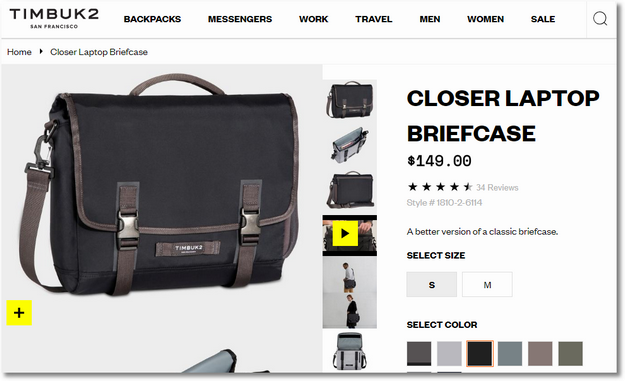
Timbuk2 pays a huge margin to its resellers to sell their messenger bags. These resellers, in turn, give a bigger cut to Amazon, who then sells the Timbuk2 bag for 30% off. Yet, when I want to pay full price on www.timbuk2.com, I have to buy a minimum of $99 to get free shipping!
I understand channel conflict, Timbuk2, but this is just plain not being hungry. You could win bigger by cultivating higher more profitable direct relationships, especially when the old world order of commerce is collapsing all around you.
And I’m ignoring the extremely light gray font reviews…on a shade grayer background!
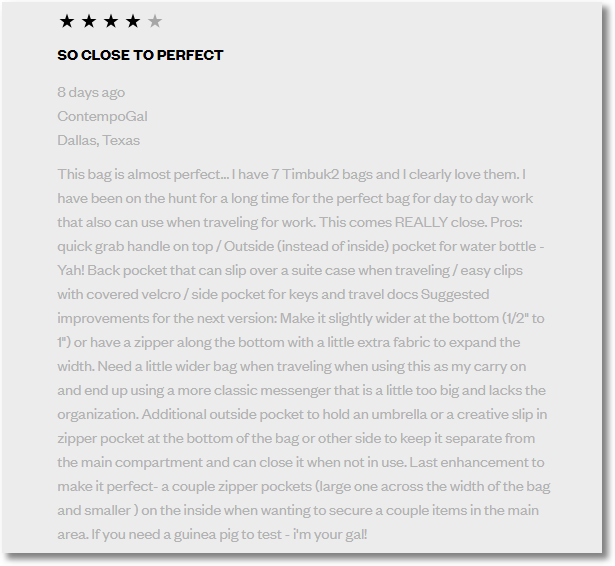
Painful.
(I really want to buy the Closer Laptop bag. The small one in Jet Black looks cool. I refused to buy it because I don’t want to reward a lack of ecommerce imagination. I am one person, I know it is not going to really hurt them, but I don’t know how else to protest a brand I love.)
Pause. Deep breath.
I do get excited about this stuff. My heart bleeds digital.
There is an ocean of opportunities when it comes to elevating ecommerce. In this post, I want to focus my passion and zero in on something that is difficult to solve for, yet immensely profitable: Inserting a sense of urgency into the shopping process.
I don’t mean: BUY IT NOW OR ELSE!
I mean developing and inserting a subtle collection of gentle nudges that can help increase the conversion rate by a statistically significant amount.
Sizing the Opportunity.
In order to have the same passion to take advantage of this magical opportunity (nudge, nudge) you’ll first want to understand how inefficient your current shopping process is.
Do two things, they’ll bring you to your knees:
1. Go look at your ecommerce conversion rate. It shows you how often you win. :) Your overall conversion rate is likely to be around 2%. You don’t need an advanced degree in math to compute that 2% winning is 98% not winning!
Do something simple. Increase current conversion rate by 25%, quantify how much increased revenue there will be. Yes, that additional $6 mil is not as hard to accomplished for an imaginative focused team – in fact you can get that from implementing half of the recommendations in this blog post.
Bonus: The best computation of conversion rate is orders divided by users (the default in your analytics tool is sessions). This will bring your conversion rate up (yea!!). Still. Big opportunity. And, yes, I did say a decade ago that you should look at the opportunity size within all your website visitors. You should. Still. The conversion headroom is massive.

2. Go to the Multi-Channel Funnels folder in Google analytics and look at two other yummy reports: Time Lag and Path Length.
They report two dimensions of speed: How long does it take for a human to convert? How many visits does it take for a human to convert?
My preferred choice is Path Length; it is rich and actionable.
This data you’ll see, the analysis you’ll do, will scare you. It will also create a sense of urgency to do something about it!
These two recommendations will help you compute the opportunity size for your management team.
Aim for quintupling revenue, obviously, but calculating just 25% improvement will give you all the budget you need from your management to insert urgency into the shopping process. Present a yummy spreadsheet that quantifies the cost of inaction, how much money you’ll lose by not delivering a 25% improvement every week. It will be heartbreaking, and now you are ready for progress!
Welcome to Nudging.
Nudging has plenty of different definitions. Mine is simple:
Another insistence of mine that you’ll note below: Nudges are based on a deep understanding of user experience. They solve for the user first, and all of the hard work is done by the company (you!).
In the long run that’ll also create a positive revenue outcome for you. Win-Win.
Below is a collection of nudges, curated from my global experiences, influenced by research and data I’ve access to.
2. Life of current price.
3. Direct competitor comparisons.
4. Delivery times based on geo/IP/mobile phone location.
5. Social cues to the rescue.
6. Personalization. Yes, from 1995!
My goal with these recommendations is to have a big impact on your ecommerce existence, and to spark your creativity as you go out and change the world.
Let’s go have some fun nudging people.
It mildly irritates me when sites don’t use this nudge.
How many hotel rooms, cameras, seats in a theater, are left?
Only 15 left in stock. Have that right under the price.
How about: Last run! Be one of the last 9 people to own this credenza design.
OMG! Click, click, click!
Or, 1 in-stock in the REI store next to your office.
Nudge. Nudge.

I’ll admit that you need to have a well-integrated logistics platform to make these ideas work. But given the decade we are in, if you have not already done that, you are facing an existential crisis. Please stop reading this post, pull in your agency and internal teams urgently to figure out how to dig your company out of this deep hole.
If you have a well-integrated logistics platform already, then all I’m asking for is this: lock your online and offline IT folks in a nice Four Seasons suite for 72 hours with your User Researchers, and BAM! Money will start falling from the sky.
Speaking of the Four Seasons, consider how sad their nudging strategy is vs. the one that booking.com has on display:
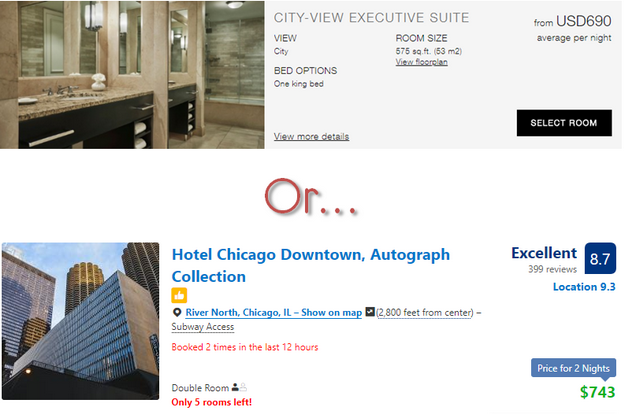
All the data you need for this nudge… You already have. That’s what makes the Four Seasons strategy, and that of most sites, so heartbreaking.
Convert the inventory status into a conversion boosting nudge.
It physically pains me how rarely this nudge is used.
Dynamic pricing is everywhere. Why not share that information with the shopper?
This price is guaranteed for the next 18 hours.
This price reflects the highest discount in the past 24 weeks.
Limited-time offer applied to the price you see.
Seasonal promotion! Expires Friday.
Reflects special pricing for our highest-tier Frequent Flyers.
Price has reduced by 14% since your last visit.
I’m sure you’ll find language and phrasing that works perfectly for you (see PS at the end of this post). There is a nugget tied to a unique dimension for your dynamic pricing strategy. Please find it, please use it.
Here’s an example from The Golf Warehouse:
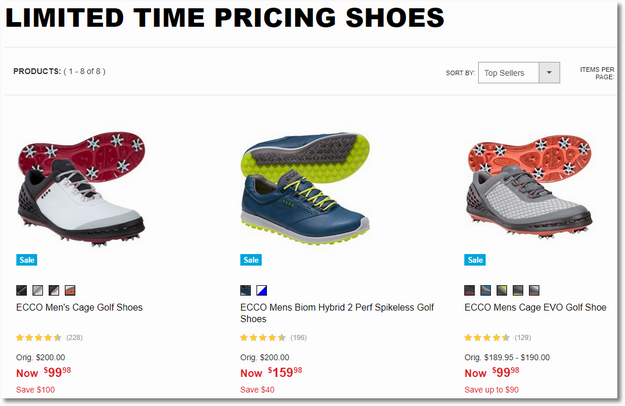
Here’s another one from Overstock that shows two time based nudges…

You can take advantage of other dimensions related to pricing that are unique to your digital strategy.
This one comes from YouTube TV: Lock-in this monthly rate for life.
YouTube TV’s price just went up from $35 to $40 (they added more channels). Everyone who’d signed up at $35 was grandfathered at that price – until they cancel!
Yet, this incredible benefit was not a part of YouTube TV’s merchandizing strategy from day one. You can imagine that a whole bunch of additional people (me!) would have jumped on board. Instead not only do I not have YouTube TV, I am sad/upset. Double loss.
You have an entire staff of economists, financial analysts, directors and VPs spending so much time on finding the perfect price to charge an individual. Why not convert that immense hard work into a nudge that creates a sense of urgency?
3. Direct competitor comparisons.
38% cheaper than Nordstrom.
Sometimes, by using one of the multitude of price aggregators, you can have an understanding of where your pricing is at an item level. Where the match is in your favor, why not use that as a nudge?
You can have the comparison for as long as it is valid. You don’t even need to specify a time—people are familiar with FOMO.
Only at B&H, this item comes with a free LG Watch!
First, who does not like free stuff?
Second, who does not like believing they are getting a special deal?
Three, who does not freak out that if they don’t buy it right away, this “insane deal” will disappear?
Me. I did that. At B&H. :)
Again, your merchandizing team is working hard to procure these amazing bundles for your customers, so why are they not a core part of your nudge strategy?
Costco Special: Get an extra year of warranty!
Our average delivery times to California are 50% faster than Amazon.
Save $150 on installation compared to Best Buy!
Our return rates are 40% lower than Wayfair.
You catch my drift.
Here’s just one example from SugarCRM:
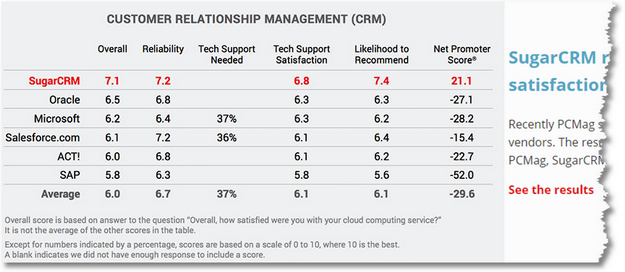
Here’s a comparison on Honda’s site…

No, actually it is from Toyota’s site.
They know that if their car is more expensive, with worse mileage etc., better to be upfront as the customers are looking for that information…
You can also go deeper when it comes to implementing the spirit of this nudge. Kendrick Astro Instruments has the normal table based competitor comparison, additionally they also have a detailed comparison with images to give you more detail…

This shows hunger and desire to win… Their text:
This is the text next to their competitor's image (which you can view in higher resolution):
Not all that hard to see how this nudge drives higher conversion rates.
Your employees stand up at 11:00 AM each day and sing the company song. There is a line in there about your company’s unique value proposition. Something so special, it stands out against everyone you compete with.
Why let that be your little secret? Why don’t you convert that into a nudge?
Consider how much louder your 11:00 AM company sing-a-long will be when your employees see you laying it out there and going head to head with your competitors.
4. Delivery times based on geo/IP/mobile phone location.
Amazon does this really well.
Each item’s estimated delivery time to you depends on the closest warehouse to your home address. So that Timbuk2 bag might be delivered to me the next day, but it would take two days to get to Carissa in Alabama.
Amazon shows this best delivery time for me right next to the price.
More often than not, I see that Prime One-Day or Prime Same-Day and, as if by magic, I find my mouse glide toward the Order Now button!
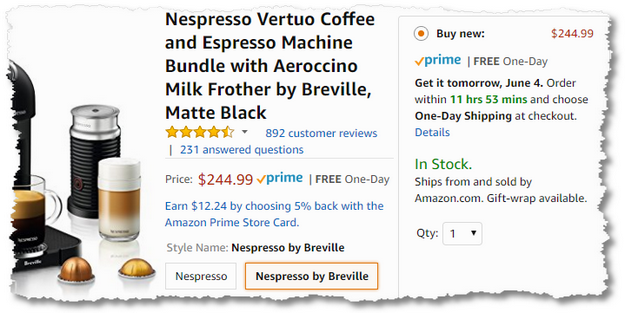
The closeness of the customer to your delivery environments remains an infrequently used strategy in creating an urgency nudge.
Another dimension of the delivery time nudge is order in the next 4 hours and get it tomorrow with fast shipping!
In our instant gratification culture, who can resist that?
You are $39 away from overnight shipping has been done to death. (If you are in this category, know that the last “secret” of ecommerce is that figuring out how to weaponize shipping – and free returns – is a powerful conversion increasing engine. Not easy, but your business model has to change to survive.)
But. If you are still in that world—don’t worry, I still love you—know that a behavioral shift from an emphasis on cost to an emphasis on the benefit will make a huge difference.
Add another $39 to your order and get your order 48 hours faster!
This takes advantage of the person’s location, your warehouse location, and your shipping policy, and frames it all as a positive nudge.
A couple more examples to inspire you.
Love these delicious sandals on Express. My wife thinks I’ll look prettier in the red, I think the Mustard really looks like my color. :)
I love the nudge they have built-in showing how many in my size are in stock (only one!)…
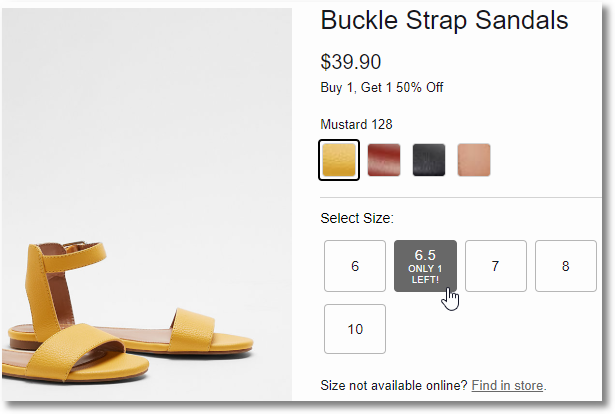
Not wanting to risk it, I click on the Find in Store link you see at the bottom of the page.
I get a interstitial that shows me availability of the sandal by geographic location…
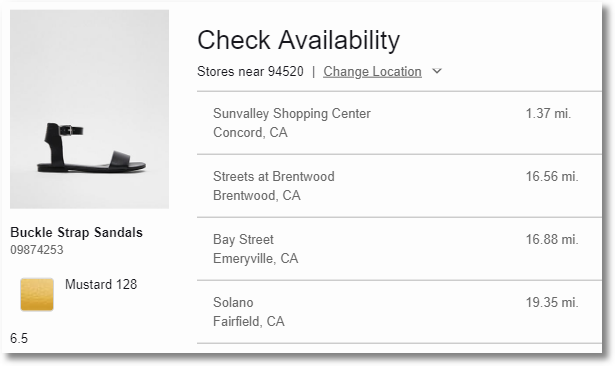
Here’s the lovely part… I did not have to do anything. Express did a reverse lookup based on my IP Address, matched that with their stores, then checked their ERP system for inventory and got me the answer. All inside one second.
Nudge, nudge!
One more.
Dominos will now deliver a pizza to you wherever you are. Literally wherever. In a park, in the dark woods, under a bridge. They look up your mobile location (with your permission), and they’ll come find you.
Assuming you want pizza that bad.
There are still websites that ask you to choose your country when you land. In this day and age, for the sake of Zeus, I hope that is not you. But, how inventively are you using the location nudge?
Significantly higher revenue awaits.
The last couple of months have not been great for social networks. I’m sure something beneficial will come to the entire digital ecosystem from all this.
A minority might believe that the whole social media thing is going to die. It is not. Community and sharing are core to who we are as humans. It is not going to change. (And, you still need a place for guilty pleasures: indulging in the latest Kardashian-West clan developments!)
Stretch your imagination and it is not hard to come up with some super-clever nudges that incorporate aggregate non-PII information that is public.
People have shared this blouse 18 times in the last hour on Instagram.
80 people in California have booked this destination in the last 30 days.
1,846 Pins for this closet on Pinterest.
Our most tweeted style of underwear!
800 plusses on Google+.
Ok, so maybe not Google+ (I was genuinely excited about it, I am sad it died). But you get the idea.
Social cues (/proof) can help create a sense of urgency for a whole host of companies. Yet, I bet you’ve rarely seen the use of this aggregated information to deliver nudges.
Here’s a simple example of aggregated non-PII based social cue, from, a site you’ve seen me express adoration for in the past, ModCloth. Every product has a little heart sign, visitors to the site vote their love which helps me make more confident decisions…
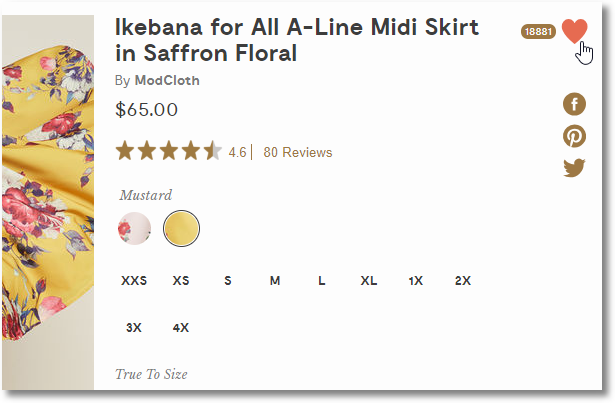
ModCloth also allows their customers to contribute something you might consider PII, their photos. These make perhaps the ultimate social proof as I can see the skirt I want (mustard again FTW!) on different body sizes…
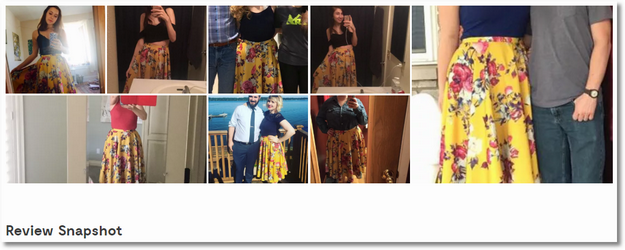
ModCloth has a whole lot of social proof strategies. They have a Style Gallery, #ModClothSquad, #MarriedinModCloth etc.
Think expansively about social proof.
Naked Wines has a lovely widget next to each of their wines that shows the would buy again rate…

And, they show you historical sales and would buy it again rates.
Checkout the Kimbao Sauvignon Blanc you can see sales and would buy it again rates since 2011. At 91%, the rate is highest this year. Sweet. Add to Basket!
Another team thinking expansively about leveraging social proof are the excellent folks at Basecamp. If you scroll to the bottom of their web pages you’ll see…

Completely non-PII based social proof, a simple cumulative trend of the number of customers. What better way to convince you to use them than this lovely up and to the right trend?
One final, massively underutilized, social proof nudge for you to consider.
Every smart ecommerce strategy has an individual-level referral program bolted on from the very start. Your current customers refer your products and services to their friends, family, and complete strangers—in exchange for a little benefit for themselves.
It is rare, however, to see the use of that referral information as a nudge.
Your friend Alex will receive $5 if you order in the next 24 hours.
The site is keeping track of the referral (to pay your friend Alex his bounty). They have all the information they need to create the above line of text. Why not use it?
Read Diana’s review of this product.
Diana, of course, referred the product to you, and that insight is in the URL you used to get to the site. The site is simply going the extra mile to surface Diana’s review, as it will likely be more meaningful to you than the other 29.
I love Patagonia; I value the brand’s ethos so deeply. And, when I say love, I mean LOVE. Two of the three pieces of clothing I’m wearing right now are from Patagonia. Yet there does not seem to be any strategy at Patagonia to help me (and you and other brand lovers) to create social cue nudges.
Humans inherently want to share, they want to show off, and they want to pass on recommendations/deals to their community. Got social nudges?
6. Personalization. Yes, from 1995!
Do you remember what I did during the last visit to your website?
No PII, just off the anonymous first-party permission-based cookie. Did you use that to change the site’s home page?
And, if you have a GDPR compliant login mechanism…Does your machine learning-powered ecommerce platform leverage the lifetime of my site experience, complaints, purchases, etc., to anticipate my activity?
Do the pages on your site wrap around my objectives, rather than your static and pimpy ones?
Is your entire sales strategy obsessed with the Do, or does it also obsess about the See, Think and Care bits of the complete human experience?
Personalization is the ultimate nudge—to create ecommerce-related urgency and to bring your brand closer to the customer over the lifetime of their experience with you.
That’s because personalization means truly caring. Personalization requires a huge investment in understanding. Personalization is translating that individual human-level understanding into anticipation. Personalization means helping. And when you do it right, personalization means you pimp with relevance—the best kind.
The desire to personalize across the complete human experiences kicks off the processes that fundamentally alter how you treat every human. The reason it works, when done right, is that deep down, we want people to care about us. And yes, we will end up doing more business with people who show that they care for us. Really care. The ultimate nudge.
So. If you own www.canada.ca or www.sainsbury.co.uk using PII or non-PII information… Does your site actively learn and then change? If not, why not?
One huge challenge we had to overcome in delivering personalization was employee capabilities. Employees are terrible at being able to imagine the expanse of possibilities when it comes being able to understand each human and being able to react to each human. Mercifully, Machine Learning (/Artificial Intelligence) will help us solve this challenge with incredible results.
Bottom-line.
You can pray that your conversion rates increase.
Alternatively, you can take advantage of the data you have access to, the permissions your users have given you, and the competitive advantages you’ve worked so hard to create and use them to create nudges that solve for delivering delight to your customers and more revenue to your company.
Your choice?
Nudging FTW!
As always, it is your turn now.
If you’ve tried one of the above six strategies to create a nudge, what was the outcome for your company? If you’ve seen a strategy for creating urgency that you love, will you please share it? What challenges have you run into in trying to personalize experiences? Nudging also works in our personal lives—have you tried it? :)
Please share your critiques, brilliant ideas and experience scars via the comments below.
PS: My doctor reminds me during every annual visit that I need to take more walks outside in the sun to make up for a vitamin deficiency. Turns out I spend too much time in my office or auditoriums. The sun is right there. I just need to take a walk. I still do it less than I should. Such is the case with A/B testing. The tools are free and abundant. You know they are the best way to win arguments with your HiPPOs or your cubicle mates. Yet, you don’t use them. I’m off to take a walk in the beautiful California sun, you go implement my recommendations for nudges as A/B tests—it is the only way to unlock the kind of imagination required to create profitable happy customer experiences.
The post Six Nudges: Creating A Sense Of Urgency For Higher Conversion Rates! appeared first on Occam's Razor by Avinash Kaushik.
from Occam's Razor by Avinash Kaushik https://ift.tt/2J71EPH
via IFTTT

